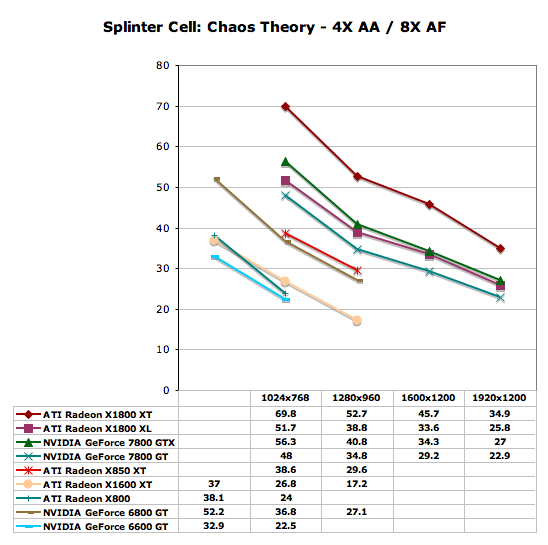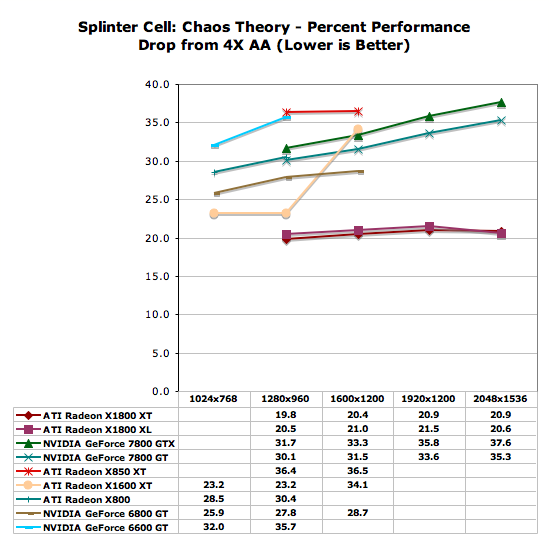ATI's X1000 Series: Extended Performance Testing
by Derek Wilson on October 7, 2005 10:15 AM EST- Posted in
- GPUs
Splinter Cell: Chaos Theory Performance
Splinter Cell: Chaos Theory is a beautiful stealth action game that makes excellent use of light and shadow. Their extended SM3.0 features are beautiful, but we tested without SM3.0 enabled for consistency. These numbers are based on the lighthouse demo that comes with the games, and we used the benchmark scripts created by Reverend of Beyond3d.
This is one of the few games that shows the X1800 XT with a clear lead over the 7800 GTX with no AA enabled. The 7800 GT still bests the X1800 XL, and the X1600 again performs on par with a much cheaper part in the 6600 GT.

Turning on AA serves to increase the X1800 XT performance advantage considerably. The future high end part from ATI will allow Splinter Cell 3 to run at 2048x1536 with 4xAA and 8xAF at a playable frame rate. The X1800XL competes directly with the 7800 GTX in this benchmark with the 7800 GT lagging behind. In this way, Splinter Cell shows us something almost the reverse of Doom 3 and Chronicles of Riddick performance.
While the X1600 XT does post better numbers than the 6600 GT, we will be more interested in how the cheaper X1600 parts will hold up against the very popular NVIDIA mid-range part.

Once again, we see the X1800 XT handle the impact of antialiasing better than all the other parts. The X1800 XL also adapts better than the NVIDIA cards. While the 6800 GT keeps up with the X1600 XT in terms of AA impact, the 6600 GT doesn't do quite as well.

Splinter Cell: Chaos Theory is a beautiful stealth action game that makes excellent use of light and shadow. Their extended SM3.0 features are beautiful, but we tested without SM3.0 enabled for consistency. These numbers are based on the lighthouse demo that comes with the games, and we used the benchmark scripts created by Reverend of Beyond3d.
This is one of the few games that shows the X1800 XT with a clear lead over the 7800 GTX with no AA enabled. The 7800 GT still bests the X1800 XL, and the X1600 again performs on par with a much cheaper part in the 6600 GT.

Turning on AA serves to increase the X1800 XT performance advantage considerably. The future high end part from ATI will allow Splinter Cell 3 to run at 2048x1536 with 4xAA and 8xAF at a playable frame rate. The X1800XL competes directly with the 7800 GTX in this benchmark with the 7800 GT lagging behind. In this way, Splinter Cell shows us something almost the reverse of Doom 3 and Chronicles of Riddick performance.
While the X1600 XT does post better numbers than the 6600 GT, we will be more interested in how the cheaper X1600 parts will hold up against the very popular NVIDIA mid-range part.

Once again, we see the X1800 XT handle the impact of antialiasing better than all the other parts. The X1800 XL also adapts better than the NVIDIA cards. While the 6800 GT keeps up with the X1600 XT in terms of AA impact, the 6600 GT doesn't do quite as well.











93 Comments
View All Comments
bob661 - Friday, October 7, 2005 - link
1280x960 is actually in keeping with the 4:3 aspect ratio. 1280x1024 actually stretches the height of your display although it's a little hard to tell the difference.TheInvincibleMustard - Friday, October 7, 2005 - link
The actual physical dimension of a 1280x1024 screen is larger than a 1280x960 if the pixel size is the same -- there's no "stretching" of anything, as 5:4 is just more square than 4:3 is but you've got more pixels to cover the "more squareness" of it.-TIM
DerekWilson - Friday, October 7, 2005 - link
It would be more of a squishing if you ran 1280x1024 on a monitor built for 4:3 with a game that didn't correctly manage the aspect ratio mapping.The performance of 1280x1024 and 1280x960 is very similar and it's not worth testing both.
TheInvincibleMustard - Friday, October 7, 2005 - link
True enough, but most 17" and 19" LCD monitors (the monitors in question in this line of posts) are native 1280x1024, and therefore no squishing is performed.I do agree with you that it is redundant to perform testing at both 1280x1024 and 1280x960, as those extra ~82,000 pixels don't mean a whole lot in the big picture.
-TIM
JarredWalton - Saturday, October 8, 2005 - link
Interesting... I had always assumed that 17" and 19" LCDs were still 4:3 aspect ratio screens. I just measured a 17" display that I have, and it's 13.25" x 10.75" (give or take), nearly an exact 5:4 ratio. So 1280x1024 is good for 17" and 19" LCDs, but 1280x960 would be preferred on CRTs.TheInvincibleMustard - Saturday, October 8, 2005 - link
By Jove, I think he's got it! :D-TIM
bob661 - Friday, October 7, 2005 - link
That might explain why I can't tell the difference. Thanks much for the info.intellon - Friday, October 7, 2005 - link
bang on with the graphs in this article... top notch. I guess the difference in performance of these cards make it less congested.On another note, I was wondering would it be too much hassle to set up ONE more computer with a mass sold cpu (say like the 3200+) and a value ram and just run couple of the different game engines on it, and post how the new cards perform? You don't have to run this "old" setup with every card ... just the new launches. It would be much helpful to common people who won't buy the fx55.
I for one, make estimates about how much slower the cards would run on my comp, but those estimates could be much better with a slower processor.
I understand that the point of the review is to let the gpu free and keep the cpu from holding it back, but testing with a common setup is helpful for someone with limited imagination (about how the card will run on their system) or not so deep pockets.
Of course you can just go right ahead and ignore this post and I won't complaint again, but if you do add such a system in the next review (it just has to be run with the new cards) I'll be the one who'll thank you deeply.
Sunrise089 - Friday, October 7, 2005 - link
2nd, even if only for a few testsLoneWolf15 - Friday, October 7, 2005 - link
One other factor in making a choice is that there are no ATI X1000 series cards available at this point. Once again, every review site covered a paper-launch, despite railing on it in the past. No-one is willing to be the first to be scooped and say "We won't review a product that you can't buy".I have an ATI card myself (replaced a recent nVidia card a year ago, so I've had both), but right now I'm pretty sick of card announcements for cards that aren't available. This smacks of ATI trying to boost its earnings or its rating in the eye of its shareholders, and ignoring its customers in the process. It's going to be a long time before I buy a graphics card again, but if I had to choose a vendor based on the past two years, both companies' reputations fall far short of the customer service I'd hope for.